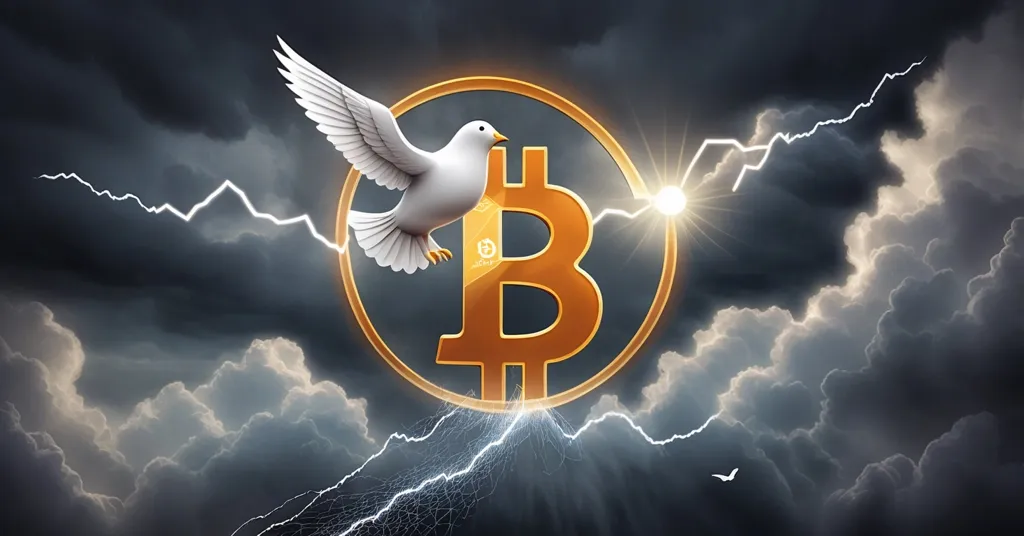Bitcoin Surges Past $106K on Trump’s Israel-Iran Ceasefire Bombshell

Will Bitcoin Price Bounce Back After Trump’s Ceasefire Announcement?
Bitcoin just pulled off a jaw-dropping $7,500 comeback in mere hours, rocketing past $106,000 after a brutal dip to $98,500. The trigger? U.S. President Donald Trump’s unexpected bombshell of a “total ceasefire” between Israel and Iran, easing global tensions and sparking a risk-on frenzy across markets, with Bitcoin riding high on the wave.
- Price Recovery: Bitcoin surges from $98,500 to over $106,000 amid geopolitical relief.
- Trump’s Move: Ceasefire announcement between Israel and Iran fuels market optimism.
- Institutional Power: MicroStrategy’s $1B Bitcoin buy and massive fund inflows drive momentum.
- Risks Loom: Fragile geopolitics and overvaluation concerns temper the hype.
Geopolitical Relief Sparks a Bitcoin Rally
When Trump took to Truth Social to declare a “complete and total ceasefire” between Israel and Iran, the crypto market—and frankly, the world—sat up and took notice. This wasn’t just a diplomatic win; it was a seismic shift for financial markets rattled by months of Middle East unrest. For context, tensions in the region often spike oil prices, which ripple through global economies and spook investors into safer assets, leaving speculative plays like Bitcoin in the dust. With crude oil prices tanking from $75 to $65 per barrel and U.S. stock index futures jumping 0.5%, the ceasefire flipped the script, creating a textbook risk-on environment. Bitcoin, often dancing to the tune of such sentiment, clawed its way back from a one-month low of $98,500 to peak above $106,000, though some fluctuations saw it settle briefly at $105,300. Still, the rebound was undeniable, as detailed in this analysis of Bitcoin’s price reaction to the ceasefire. But let’s not get too cozy—initial confusion around the agreement, only later confirmed by a senior Iranian official, hints that this peace could be as fragile as a house of cards. If tensions reignite, Bitcoin’s rally could vanish faster than a meme coin pump.
Macro Tailwinds: Fed Rate Cuts on the Horizon
Beyond geopolitics, Bitcoin’s resurgence is getting a boost from macroeconomic whispers. The CME FedWatch tool shows a 53% probability that the U.S. Federal Reserve will slash interest rates to 3.75% or lower by November. Why does this matter? Lower rates mean cheaper borrowing and less allure for parking cash in safe, yield-bearing assets like bonds. Historically, this pushes investors toward high-risk, high-reward bets—think Bitcoin. Look back to the post-2020 pandemic easing: Fed rate cuts unleashed a torrent of liquidity, and Bitcoin soared from under $10,000 to nearly $69,000 by late 2021. While we’re not predicting a repeat, the setup is eerily familiar, and you can explore more about Bitcoin’s historical trends on Bitcoin’s price volatility page. For crypto bulls, especially Bitcoin maximalists who see it as digital gold unshackled from central bank meddling, this is music to their ears. Yet, rate cuts aren’t a guaranteed crypto moonshot—global economic hiccups could still derail the party.
Institutional Heavyweights Double Down
While world leaders play peacemaker, corporate giants are waging their own war on traditional finance with Bitcoin as their weapon of choice. MicroStrategy, the poster child for corporate crypto adoption, just dropped a staggering $1 billion on Bitcoin, issuing nearly $979.7 million in preferred stock to fund the haul—quadrupling their original $250 million plan. This isn’t a gamble; it’s a neon sign of institutional confidence, as outlined in this report on MicroStrategy’s massive Bitcoin purchase. Crypto investment funds echoed the sentiment, pulling in $1.24 billion in inflows last week, with Bitcoin alone snagging $1.1 billion. Even short-Bitcoin products saw $1.4 million in outflows, signaling that bears are packing up and going home. Curious about why companies like MicroStrategy are diving in? Check out this discussion on institutional inflows.
But here’s the rub: not everyone’s buying the hype at face value. Markus Thielen of 10x Research warns that MicroStrategy’s stock trades at a +112% “Bitcoin premium,” meaning retail investors might be shelling out way more for exposure than the raw asset is worth. It’s like buying a Tesla for the price of a private jet—sure, you get the cachet, but at what cost?
Every time MicroStrategy issues new shares to retail investors… the company pockets the difference and frames it as Bitcoin yield.
VanEck backs this up, noting the premium is fueled by speculation on future accumulation and regulatory perks. A Bitcoin maximalist might counter that overvaluation doesn’t matter if BTC’s long-term trajectory as a pristine store of value holds true. Fair point, but for the average investor, this smells like a potential bubble waiting to pop. Institutional muscle is a boon, no doubt, but let’s not drink the Kool-Aid without checking the ingredients. For deeper insights, see this breakdown of MicroStrategy’s Bitcoin strategy.
Trump Media’s ETF Gamble: Hype or Substance?
Adding another layer of intrigue, Trump Media—tied to the former president himself—is making a splash with a $400 million stock buyback and a hefty $2.3 billion capital raise. The real eyebrow-raiser? Their filing with the SEC to launch a dual Bitcoin (75%) and Ethereum (25%) ETF under the Truth Social brand. If approved, this could rope in a fiercely loyal retail base tied to Trump’s persona, injecting fresh energy into the crypto market, as covered in this update on Trump Media’s ETF filing. But don’t start celebrating just yet. The ETF space is a shark tank, dominated by behemoths like BlackRock, who manage $72.5 billion in Bitcoin ETF assets alone. Trump Media’s undisclosed fees will need to undercut competitors’ razor-thin 0.12% to make a dent, or lean hard on brand loyalty.
It will be a challenge for any new entrant in this market. The only way to stand out will be through fees or brand.
Bryan Armour of Morningstar nails it—success isn’t guaranteed. Sui Chung of CF Benchmarks adds that there’s nothing structurally innovative here; it’s all about marketing to a niche crowd. And what if the SEC says no? Or if the Trump branding polarizes investors more than it unites them? This could easily morph from a decentralized dream into a centralized publicity stunt. For now, it’s speculative fuel for the rally, but we’re keeping our skepticism dialed up.
Network Hiccups: Should We Worry About Hashrate?
Amid the bullish roar, a quiet glitch has surfaced: Bitcoin’s hashrate—the total computing power securing the network—dropped 8% last week. Rumors point to disruptions in Iran, a country allegedly burning up to 2GW of electricity on unofficial mining operations. For the uninitiated, hashrate measures how much muscle miners throw at validating transactions and keeping the blockchain tamper-proof. A dip can mean fewer miners online, often due to power costs or, in this case, geopolitical chaos. Iran’s role in mining isn’t trivial—some estimates suggest it contributes a notable slice of global hashrate, though exact figures are murky. State-sponsored or illicit mining can be a double-edged sword, boosting decentralization by spreading nodes globally, yet risking crackdowns that jolt the network.
Before you panic, though, analysts like Daniel Batten are shrugging it off. They point to past drops—like a 27% plunge during U.S. storms in April—that Bitcoin weathered without breaking a sweat. The network’s decentralized design means no single point of failure, and with open interest (the total value of unsettled futures bets) still towering at $68 billion despite $193 million in recent long liquidations, the market’s spine seems solid. Still, these hiccups remind us that Bitcoin’s security isn’t invincible—geopolitical hot zones could always throw a wrench in the works.
Altcoin Surge: Beyond Bitcoin’s Shadow
Bitcoin’s rally isn’t a solo act; altcoins are stealing some of the spotlight. Ethereum, XRP, Cardano, Polkadot, Solana, and even obscure players like Pi Network are basking in the glow, with some like Ethereum and Solana posting sharper gains of 8-10% compared to Bitcoin’s 3% in certain windows. Why the outperformance? Ethereum’s appeal lies in staking yields post its 2022 merge to proof-of-stake, offering passive income Bitcoin can’t match. Solana, meanwhile, draws risk-takers with its dirt-cheap transaction costs and booming DeFi ecosystem. This isn’t a threat to Bitcoin’s dominance as the ultimate store of value—it’s a complement. Altcoins fill niches Bitcoin isn’t built for, like smart contracts on Ethereum or cross-chain bridges on Polkadot. As a Bitcoin-leaning outfit, we’ll always crown BTC king, but we can’t ignore the parallel empires being built. This rally shows the crypto ecosystem’s strength lies in its messy, chaotic diversity.
Risks and Realities: Keeping Our Feet on the Ground
Let’s cut through the euphoria. Bitcoin’s bounce is fueled by a perfect storm of geopolitical reprieve, institutional flexing, and macro tailwinds, but cracks are everywhere. The ceasefire could crumble at the first sign of renewed conflict—peace in the Middle East isn’t exactly a safe bet. Overvaluation in corporate plays like MicroStrategy screams caution, and unproven ventures like Trump Media’s ETF could fizzle if regulatory or market hurdles bite. Then there’s the $110,000 price target floating around—pure tea-leaf reading. We’re not here to shill baseless predictions; markets are fickle, and volatility is crypto’s middle name, as community reactions on platforms like Reddit highlight Bitcoin’s price swings post-ceasefire. Bitcoin’s open interest at $68 billion shows strong engagement, but liquidations hint at overleveraged players ready to get burned. We’re all for effective accelerationism and smashing the financial status quo, but blind optimism is a fool’s errand. For new investors caught in the hype, a reminder: crypto is a wild ride—do your homework before jumping in.
Looking Ahead: Catalysts to Watch
Bitcoin’s latest surge is a middle finger to centralized chaos, a testament to its potential as the future of money. But the path forward isn’t a straight line. If the ceasefire holds, could we see Bitcoin test all-time highs? If it collapses, what support levels might hold? Keep an eye on Fed rate decisions, institutional inflows, and geopolitical headlines—they’ll shape the next chapter, as explored in this analysis of Bitcoin surges tied to geopolitical events. We’re rooting for this financial revolution, but only if we build it on ruthless skepticism and truth, not fairy tales. Decentralization, privacy, and freedom are worth fighting for, and Bitcoin remains the unassailable spearhead—let’s just navigate the battlefield with eyes wide open. For a broader perspective on the current market dynamics, see this report on Bitcoin’s potential price recovery.
Key Takeaways and Questions
- What drove Bitcoin’s surge past $106,000?
Trump’s ceasefire announcement between Israel and Iran eased global tensions, while expectations of Federal Reserve rate cuts amplified risk-on sentiment for Bitcoin. - How are institutional players shaping the crypto market?
MicroStrategy’s $1 billion Bitcoin purchase and $1.24 billion in fund inflows signal unshakable confidence, though overvaluation risks like MicroStrategy’s +112% premium warrant caution. - Can Trump Media’s ETF filing move the needle?
It adds bullish hype, but SEC approval is uncertain, and competition from giants like BlackRock means success hinges on fees or brand loyalty. - Is Bitcoin’s 8% hashrate drop a red flag?
Not likely—analysts highlight the network’s resilience to past dips, though disruptions in regions like Iran expose ongoing vulnerabilities in mining decentralization. - Are altcoins challenging Bitcoin’s dominance?
Not directly; Ethereum and Solana’s sharper gains (8-10%) reflect unique strengths like staking and DeFi, complementing Bitcoin’s role as a store of value. - Is a $110,000 Bitcoin target realistic soon?
It’s a gamble—while institutional and geopolitical tailwinds support momentum, market volatility and fragile peace deals could unravel gains in a heartbeat.



